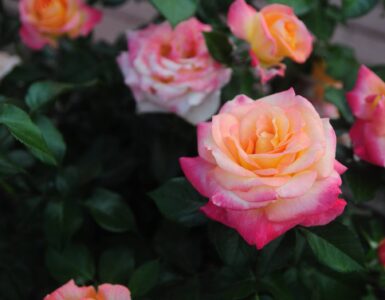Refreshing taste buds and an excellent source of vitamins, minerals, and natural antibiotics, fruit is the ideal food for eating your way to good health.
Darin Engh, from Engh Gardens shares some recipes and helpful tips on how to make your garden more fruitful.
Grow Some Fruit Trees in Your Garden
Fruit trees are at home in and have been historically important in the kitchen garden. Apple and pears can be trained into decorative and useful backdrops and windscreens. Their spring flowers are dramatic, decorative, and often as fragrant as other spring-flowering trees. And, a bountiful crop of fruit rewards the grower each fall.
Trees are the most permanent part of the garden; some may last a hundred years or more. Gardeners can choose from a selection of trees that are disease resistant, reach smaller ultimate size, yield better fruit quality, and withstand wider temperature extremes.
Sweet Cherry and sour cherry or tart cherry trees have lots of gorgeous spring flowers, good foliage, attractive and tasty fruit, and supply winter interest with decorative bark. Sweet cherries grow in zones 5 to 9. The fruit can be eaten raw or cooked. Sour cherries, or pie cherries, grow in zones 4 to 9 and produce fruit that is usually cooked, though some people enjoy their fresh, tart flavor. Trees grow from 8 to 20 feet tall. ‘Montmorency’ is a particularly good sour cherry that grows 12 to 15 feet tall. Plant two tree for pollination.
Peach and nectarine trees produce juicy sweet fruit after showy, pink spring flowers. The main difference between them is fuzz; peaches have it, nectarines do not. They grow 20 to 25 feet tall. Prune to hold the maximum height to 10 feet. Plant in full sun in moist, sandy loam soil. They are generally hardy in zones 5 to 9. Peaches have more cold-tolerant varieties than nectarines.
Pear trees bear fruit of great range: colors of green, yellow, brown, or bright red; skin rough or smooth; flavor mild to rich; and flesh buttery to gritty or crisp to soft. They are attractive trees with snowy white spring flowers, glossy green leaves, and fall fruit. Pears are hardy in zones 4 to 9. Plant in sun in deep, well drained soil, in two varieties for best pollination and fruit production.
A single fruit tree can scarcely be called an orchard, but in a small garden where every plant has to work hard for its living, one is better than none. A fruit tree is as beautiful to look at in spring as any purely ornamental tree and twice as useful in fall when you can gather in your own home-grown fruit. Why not have beauty as well as food?
Add Some Berries to Your Garden
Strawberries are the most popular homegrown fruit, probably because they are the easiest to grow. Strawberries are categorized by when they fruit. June-bearing types produce fruit when days are short. Everbearing varieties are somewhat smaller plants. They produce flavorful, smaller fruit, one crop in spring then a second, lighter crop in autumn, and continue to flower while in fruit. Yield will vary by variety with best flavor produced form plants with the lowest yield. Most plants will give you about 2 cups of fruit per season. Plant in full sun in sandy loam enriched with organic matter. Plant with crowns at soil level. Space plants 18 inches apart and rows 3 feet apart.
The rich essence of raspberries is best supplied by growing your own, because the tasty fruit does not ship well. Raspberries are easy to grow in a sunny spot in fertile, well-drained soil. They prefer a slightly acidic soil and benefit much from mulching. Plants need a good supply of moisture to do will. Well-prepared soil with organic amendments will produce the best results. Prune the fruiting canes of raspberries in the fall. Berries will form on new canes. Most raspberries are hardy in zones 4 to 9. Black raspberries are the most heat-tolerant. For ease of harvesting and neatness, support canes on wires stretched between posts. In the red category, ‘Heritage’ is a widely planted, excellent everbearer.
Blueberries are tasty, succulent, very useful fruit and are easy to grow in proper soil. They prefer a very acidic soil. They will tolerate heavy soils with good drainage but prefer a sandy loam, during growth and fruiting. They are suitable for container growing. When full grown, a plant will yield about 10 quarts of berries per year. Blueberries are hardy in zones 4 to 9. Blueberries are terrific in an informal garden or woodland edge because of the wonderful fall colors. The plants blaze in red, orange, and copper. For best fruit production, plant two different varieties. Fertilize annually and use organic mulch.
Fruit Garden Smoothies and Salad Recipes
This medley of summer berries makes an inspired drink.
Ingredients:
4 tbsp orange juice
1 tbsp lime juice
Scant ½ cup sparkling water
2 1/3 cups frozen summer fruits (such as blueberries, raspberries, blackberries, and strawberries)
4 ice cubes, crushed
Directions:
Pour the orange juice, lime juice and sparkling water into a food processor and process gently until combined. Add the summer fruits and ice cubes and process until a slushy consistency has been reached. Pour the mixture into glasses, then decorate with whole raspberries and blackberries on toothpicks and serve.
Pink, light, and fruity, this refreshing smoothie is simply delicious.
Ingredients:
2 large ripe Anjou pears
Scant 1 cup frozen raspberries
Generous ¾ cup ice-cold water
Honey, to taste
Directions:
Peel the pears and cut into fourths, removing the cores. Put into a food processor with the raspberries and water and process until smooth. Taste and sweeten with honey if the raspberries are a little sharp. Pour into glasses and serve.
Blueberries are still a much underrated pleasure.
Ingredients:
Scant ½ cup strained plain yogurt
Scant ½ cup water
Scant 1 cup frozen blueberries
Directions:
Put the yogurt, water, and blueberries into a food processor and process until smooth. Pour into glasses and top with whole frozen blueberries.
This drink combines the rich flavors and colors of summer fruits in one superb smoothie.
Ingredients:
1 ½ cups orange juice
1 banana, sliced and frozen
3 cups frozen forest fruits (such as blueberries, raspberries, and blackberries)
Directions:
Pour the orange juice into a food processor. Add the banana and half of the frozen fruits and process until smooth. Add the remaining forest fruits and process until smooth. Pour the mixture into tall glasses and decorate the rims with slices of fresh strawberry. Add straws, and serve.
Summer fruit crush with peach, nectarine, apricots, and raspberries
Ingredients:
1 ripe peach, peeled and halved
1 ripe nectarine, halved
2 ripe apricots, halved
Handful of raspberries
6 ice cubes
Sparkling water, to taste
Honey or sugar (optional)
Directions:
Discard the pits from the fruit. Put all fruit into a blender, add the ice and enough sparkling water to make the blades run. Blend to a puree. Taste and add honey or sugar, if preferred, and enough extra water to produce the consistency you like. Pour into glasses and serve.
Fruit salad lassi with strawberries
Ingredients:
1 cup low-fat plain yogurt
½ cup low-fat milk
6 large strawberries
Choice of fruit, such as:
1 cup raspberries, or
Apricots or peaches, pitted
Sugar to taste.
Crushed ice, to serve
Directions:
Put all ingredients except the sugar an ice into a blender and blend to a puree. Taste, add sugar if preferred, and pour into glasses filled with crushed ice.
For more information on fruit trees or plants you can contact Darin at Engh Gardens in Sandy
or online at http://enghgardens.com/















Add comment